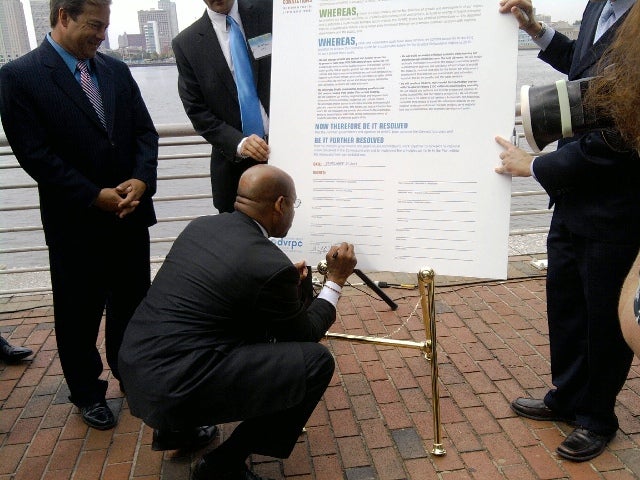DVRPC’s long-range plan for dealing with region’s growth
Sept. 24
By Kellie Patrick Gates
For PlanPhilly
Political leaders and planners from around the Philadelphia region Thursday endorsed a 25-year growth management plan that calls for preserving open space, improving transit, concentrating growth along transit lines and in the area’s dense, walk-able communities as well as reducing greenhouse gas emissions by 50 percent.
“This long-range plan will set the Greater Philadelphia region on a course for smart growth that realizes a collective vision for a more sustainable approach to the way we live, work, and play in the nine-county area,” said Barry Seymour, executive director of the Delaware Valley Regional Planning Commission, the organization that authored the plan. “Our core pillars of managing resources, creating livable communities, enhancing energy-efficiency, and modernizing the transportation infrastructure provide a specific plan for the region’s future.”
Called “Connections – the Regional Plan for a Sustainable Future,” the plan aims to better coordinate development in Philadelphia, Chester, Camden and Trenton and the counties surrounding them: Bucks, Chester, Delaware and Montgomery in Pennsylvania and Burlington, Camden, Gloucester and Mercer in New Jersey. The plan was announced and the resolution for it symbolically signed outside Camden’s Adventure Aquarium, across the Delaware from Center City Philadelphia.
“By concentrating new growth and development in specific locations we can revitalize existing cities and boroughs, reduce infrastructure costs, reduce energy demands, help control sprawl and preserve open space,” said DVRPC Board Chairman and Camden County Freeholder Director Louis Cappelli Jr.
https://www.youtube.com/watch?v=oOisMwas7Z4
Many planning and elected leaders have lately been calling for this kind of regional approach, saying that without it, this region will not be able to compete globally. Penn School of Design Dean Marilyn Jordan Taylor talks about this frequently, as did experts Alex Krieger, a founding principal of Chan Krieger Sieniewicz and professor at the Harvard Graduate School of Design, and Trent Lethco, associate principal of ARUP Inc., when they came to Philadelphia in July to discuss the best urban development practices they have seen in cities around the world.
But the estimated, as-yet-unfunded costs of implementation are not small: $100 million per year, or $2.5 billion over the 25-year life of the plan.
“It will be a heavy lift, there’s no question about it,” said Philadelphia Mayor and DVRPC board member Michael Nutter when asked where the money will come from.
“It’s like any other great and worthy cause. If you put the politics together right, if you can demonstrate that you have a vision and you know where you’re trying to go, the economics of this will more than pay for itself,” he said. “And the long-term growth of this region is really tied into this plan. So, you know, so I think if people look at it for all the right reasons and the legitimate purpose of what we’re trying to accomplish, you lay out the economics of it, it just makes good common sense.”
While exactly where the money will come from has yet to be determined, Seymour said after the press conference that some options are already being explored. “We’re looking at potentially tolling certain roads,” he said.
A two-year study into the possible tolling of US 422 – which links Valley Forge to Pottstown – has just begun, Seymour said. Tolls would be used both to pay for highway improvements and to expand mass transit, Seymour said. The DVRPC doesn’t have the power to levy the tolls. Depending on the roadway in question, that could require federal, state and/or local approvals, he said. Another funding option: The creation of a new regional authority with the power to raise money.
https://www.youtube.com/watch?v=rvYtRdxdQ3Q
https://www.youtube.com/watch?v=L7UWWYDotLg
According to the document, the nine-county region is expected to have gained more than 630,000 residents and 370,000 jobs between 2005 and 2035, increases of 11 and 13 percent, respectively.
“Current trends forecast that the vast majority of regional population and employment growth could occur on the region’s periphery in areas without sufficient infrastrure to support the growth,” reads a DVRPC press statement. “The plan is intended to shift those trends.”
The political leaders at the press conference said the shift was already occurring naturally, and the plan seeks to bolster it and keep it happening in a coordinated way.
This region has been very active in preserving open space in recent years. “Local governments generate over $100 million annually for open space preservation, funds that are typically matched by state dollars,” said Chester County Commissioner and past DVRPC Board Chairwoman Carol Aichele. “Efforts to protect, and in some instances, restore open space will save only by containing the need for increased infrastructure to support drinking water and wastewater management, as well as ensure that folks have inviting places to go for recreation, relaxation, and exploration.”
Montgomery County Commissioner Joseph M. Hoeffel, who is the DVRPC’s treasurer, said more people also want to live in walk-able, urban areas and use public transit.
“It’s not so much that elected officials have to convince the public that this is something good for them, they are saying to us, ‘You’ve got to change what’s happening. You’ve got to make downtowns and cities livable. You’ve got to make sure we’re not all buying houses out on a farm, a former farm field, where there’s no corner store within five miles, or a development with no sidewalks, where we can’t even walk around our neighborhoods,’” he said.
Still, up until the housing market crashed, many acres of farmland and woodland were being turned into housing developments. In addition to land preservation, it may take new municipal zoning to change that.
https://www.youtube.com/watch?v=4rva2c3lk58
Since the plan calls for concentrating growth in areas with infrastructure, this would mean limiting growth – including commercial growth – in areas with limited infrastructure. When asked how the officials in such communities could be persuaded to go along with the plan, when it could mean less tax revenues, Cappelli said that at least in New Jersey, this is what they want.
“Many of the municipalities in Gloucester County, in Burlington County, have said we don’t want development. We don’t want to develop our farmlands, we don’t want to create and build new schools. What we’d like to see happen is development take place in some of the first-ring suburbs,” he said.
“And what we’re also seeing here is there’s a real, real strong demand to live in locations near the city of Philadelphia, where there’s easy access to Philadelphia either by the bridges or by public transit.”
So far as commercial growth goes, Aichele said companies can be convinced to locate near mass-transit and in dense communities because it helps them attract workers. Likewise, those same workers want not only to live in walk-able areas, but near preserved space, she said.
Contact the reporter at kelliespatrick@gmail.com
WHYY is your source for fact-based, in-depth journalism and information. As a nonprofit organization, we rely on financial support from readers like you. Please give today.






